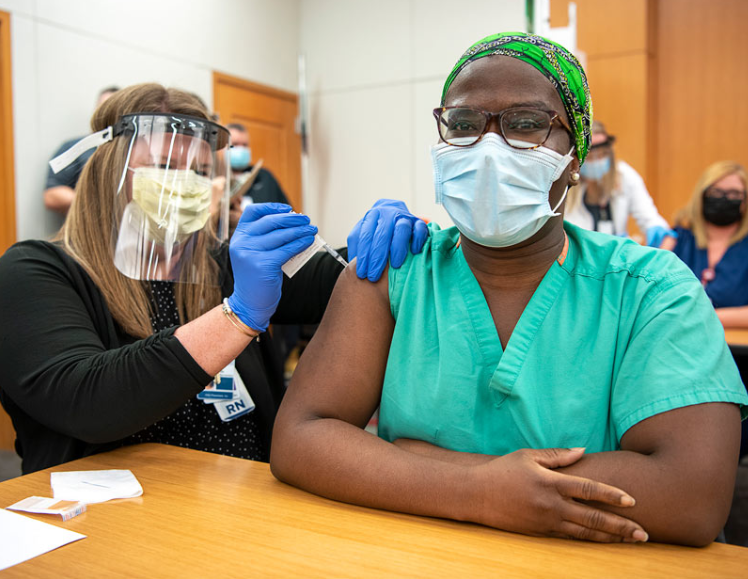With COVID-19 on the rise in Franklin County, officials uncertain of vaccine access

- Oops!Something went wrong.Please try again later.
While numbers remain low, COVID-19 cases are slightly on the rise in central Ohio and across the nation.
Officials with the Ohio Department of Health said they don't believe a major surge is coming anytime soon, and no new COVID variants have been detected among recently reported cases.
"We still are experiencing some of the lowest levels of case numbers since the start of the pandemic," said ODH Director Bruce Vanderhoff at a Thursday press conference. "Consider this: one year ago, on August 17, 2022. There had been over 23,000 new cases in the previous week. Last week, there were just under 3,000."
But health officials say potential disparities in access to vaccines and booster shots could be a challenge in the coming months.
What are the COVID-19 numbers around Columbus and Ohio?
During the first week of August, some 399 people tested positive for COVID-19 in Franklin County, according to the state's COVID-19 dashboard. However, the county's cases remain lower than the same time last year, and the county is classified as a low-risk area for COVID transmission.
The summers of 2020, 2021 and 2022 saw increases in cases, hospitalizations and deaths. This summer, the upswing is coming later and is much smaller, data suggests.
More: COVID rates are climbing but nowhere near what they were. This year's story is different.
OhioHealth has seen 45 people admitted to the hospital system in the past week with COVID-19, up from 34 the previous week and 26 two weeks ago, said Dr. Joe Gastaldo, OhioHealth's vice president of clinical affairs. They're also recording a positivity rate of about 20%, meaning that one in five patients reporting symptoms of COVID-19 have received a positive test.
The virus that causes COVID isn't going away, Dr. Gastaldo said. But for the time being, no new variants are being detected in our area, and local hospitals are having no trouble dealing with a slight influx of patients.
With emergency order lifted, treatment could be harder to come by
An updated booster is expected to be approved by the federal Food and Drug Administration and the Centers for Disease Control sometime this fall.
ODH spokesperson Michelle Sumner said the new booster "targets the XBB variant of Omicron that currently is predominant," and that ODH will release further information on the booster when it becomes available.
Yet since the federal Public Health Emergency declaration was lifted, there's been some "ambiguity" on how new vaccines will be administered, Dr. Gastaldo said.
More: What the end of the federal COVID-19 public health emergency means for Ohio
Tests, vaccines and treatments are still available, but there's no guarantee that they'll be free going forward. The end of the emergency order meant that some may have to pay for COVID treatment with insurance, or out-of-pocket. Insurers are also no longer required to offer free COVID tests. According to the CDC, COVID vaccines and treatments like Paxlovid will continue to be offered for free "while supplies last."
Franklin County Public Health still has free vaccines available from the federal government, and Assistant Health Commissioner Alex Jones said the county is encouraging individuals to get vaccinated while supplies are available. Immunization clinic availability for Franklin County can be found on the FCPH website.
Officials across the state remain uncertain when the vaccine will stop being publicly funded, Jones said.
Once these free supplies run out, "it's not necessarily clear what it's going to be looking like for access for people who have insurance, and for those who don't have insurance," Dr. Gastaldo said.
With a new vaccine on the horizon, Ohio officials are working to ensure that residents have equal access to treatment, with or without insurance. ODH officials said they're "confident" they can supply free doses of the new vaccine.
The federal Vaccines For Children program provides free doses of the vaccine to eligible children, including those who are uninsured. The CDC's Bridge Access Program helps provide treatment for uninsured adults, and federal officials have indicated that they hope to prioritize vaccinating low-income and marginalized Americans, Dr. Gastaldo said.
LCarey@Dispatch.com
@LilyLCarey
This article originally appeared on The Columbus Dispatch: COVID-19 cases rising in Columbus, but fall vaccine access uncertain

